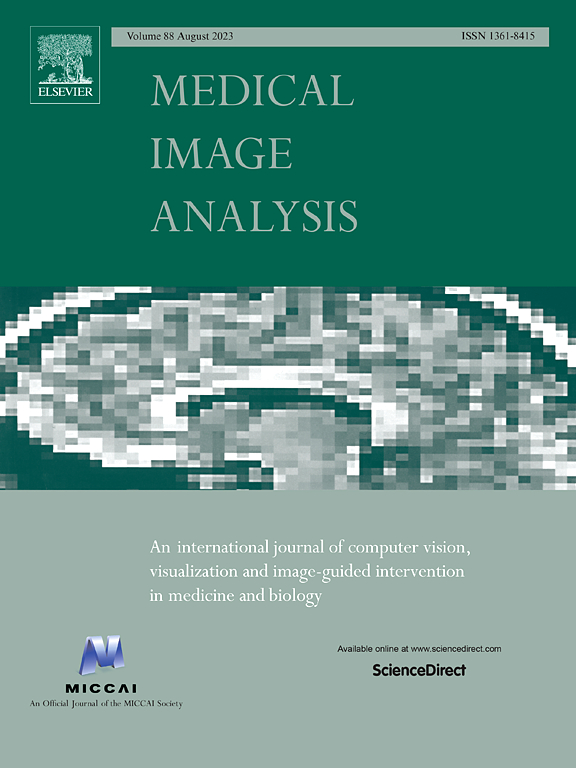Multidimensional Directionality-Enhanced Segmentation via large vision model
IF 10.7
1区 医学
Q1 COMPUTER SCIENCE, ARTIFICIAL INTELLIGENCE
引用次数: 0
Abstract
Optical Coherence Tomography (OCT) facilitates a comprehensive examination of macular edema and associated lesions. Manual delineation of retinal fluid is labor-intensive and error-prone, necessitating an automated diagnostic and therapeutic planning mechanism. Conventional supervised learning models are hindered by dataset limitations, while Transformer-based large vision models exhibit challenges in medical image segmentation, particularly in detecting small, subtle lesions in OCT images. This paper introduces the Multidimensional Directionality-Enhanced Retinal Fluid Segmentation framework (MD-DERFS), which reduces the limitations inherent in conventional supervised models by adapting a transformer-based large vision model for macular edema segmentation. The proposed MD-DERFS introduces a Multi-Dimensional Feature Re-Encoder Unit (MFU) to augment the model’s proficiency in recognizing specific textures and pathological features through directional prior extraction and an Edema Texture Mapping Unit (ETMU), a Cross-scale Directional Insight Network (CDIN) furnishes a holistic perspective spanning local to global details, mitigating the large vision model’s deficiencies in capturing localized feature information. Additionally, the framework is augmented by a Harmonic Minutiae Segmentation Equilibrium loss () that can address the challenges of data imbalance and annotation scarcity in macular edema datasets. Empirical validation on the MacuScan-8k dataset shows that MD-DERFS surpasses existing segmentation methodologies, demonstrating its efficacy in adapting large vision models for boundary-sensitive medical imaging tasks. The code is publicly available at https://github.com/IMOP-lab/MD-DERFS-Pytorch.git.
基于大视觉模型的多维方向性增强分割。
光学相干断层扫描(OCT)有助于黄斑水肿和相关病变的全面检查。手动划定视网膜液是劳动密集型和容易出错,需要一个自动化的诊断和治疗计划机制。传统的监督学习模型受到数据集限制的阻碍,而基于transformer的大视觉模型在医学图像分割方面表现出挑战,特别是在检测OCT图像中的小而微妙的病变方面。本文介绍了多维方向性增强视网膜液体分割框架(MD-DERFS),该框架采用基于变压器的大视觉模型对黄斑水肿进行分割,减少了传统监督模型固有的局限性。提出的MD-DERFS引入了多维特征重新编码器单元(MFU),通过定向先验提取增强模型识别特定纹理和病理特征的熟练程度;引入了水肿纹理映射单元(ETMU);引入了跨尺度定向洞察网络(CDIN),提供了从局部到全局细节的整体视角,减轻了大视觉模型在捕获局部特征信息方面的不足。此外,该框架还增加了调和细节分割平衡损失(LHMSE),可以解决黄斑水肿数据集中数据不平衡和注释稀缺性的挑战。对MacuScan-8k数据集的实证验证表明,MD-DERFS超越了现有的分割方法,证明了其在适应大视觉模型进行边界敏感医学成像任务方面的有效性。该代码可在https://github.com/IMOP-lab/MD-DERFS-Pytorch.git上公开获得。
本文章由计算机程序翻译,如有差异,请以英文原文为准。
求助全文
约1分钟内获得全文
求助全文
来源期刊

Medical image analysis
工程技术-工程:生物医学
CiteScore
22.10
自引率
6.40%
发文量
309
审稿时长
6.6 months
期刊介绍:
Medical Image Analysis serves as a platform for sharing new research findings in the realm of medical and biological image analysis, with a focus on applications of computer vision, virtual reality, and robotics to biomedical imaging challenges. The journal prioritizes the publication of high-quality, original papers contributing to the fundamental science of processing, analyzing, and utilizing medical and biological images. It welcomes approaches utilizing biomedical image datasets across all spatial scales, from molecular/cellular imaging to tissue/organ imaging.
 求助内容:
求助内容: 应助结果提醒方式:
应助结果提醒方式:


